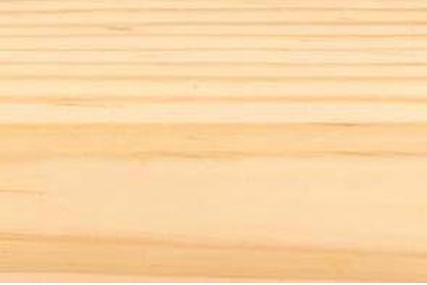Scots pine is a softwood used for general construction purposes, flooring and joinery.
Baltic pine, Nordic redwood, Scots fir, Scotch fir, Riga pine, Norway pine, Mongolian pine, red deal, yellow deal
Pinus sylvestris
Scots pine is a softwood originating from northern Europe and Asia, the sawn form of which is used in general construction, flooring, paneling and interior joinery. Treated with preservatives it has also been used for poles and pit props.
The sapwood of Scots pine is 50-100mm wide, creamy white or pale yellow, and readily identified from the yellow-brown to reddish brown heartwood. Its texture is relatively fine and the grain is usually straight. The growth rings are prominently marked by the darker, denser summerwood. The knots are usually grouped, whereas in White Baltic Pine they are much more randomly distributed. The wood is resinous; it is of low durability and not susceptible to lyctid borer.
Shrinkage
| Very Low | Low | Medium | High | Very High | |
|---|---|---|---|---|---|
|
|
|
||||
|
Tangential :
|
3.50% | ||||
|
Radial :
|
1.50% | ||||
|
Unit Movement Tangential:
|
0.30% | ||||
|
Unit Movement Radial:
|
0.14% |
Strength Group
| Very High | High | Reasonably High | Medium High | Medium | Reasonably Low | Low | Very Low | |
|---|---|---|---|---|---|---|---|---|
| Unseasoned: | S1 | S2 | S3 | S4 | S5 | S6 | S7 | S8 |
|
|
||||||||
| Seasoned: | SD1 | SD2 | SD3 | SD4 | SD5 | SD6 | SD7 | SD8 |
|
|
Stress Grade
|
Structural No. 1 |
Structural No. 2 |
Structural No. 3 |
Structural No. 4 |
Structural No. 5 |
|
|---|---|---|---|---|---|
| Unseasoned: | F7 | F5 | F4 | ||
| Seasoned: | F14 | F11 | F8 | F7 | F5 |
Density per Standard
| Seasoned: | 560kg/m3 |
|---|---|
| Unseasoned: | 845kg/m3 |
Joint Group
| Very High | High | Reasonably High | Medium | Low | Very Low | |
|---|---|---|---|---|---|---|
| Unseasoned: | J1 | J2 | J3 | J4 | J5 | J6 |
|
|
||||||
| Seasoned: | JD1 | JD2 | JD3 | JD4 | JD5 | JD6 |
|
|
Colour
| White, yellow, pale straw to light brown | Pink to pink brown | Light to dark red | Brown, chocolate, mottled or streaky | |
|---|---|---|---|---|
|
|
||||
Mechanical Properties
|
Modulus of Rupture - Unseasoned:
|
44 |
|---|---|
|
Modulus of Rupture - Seasoned:
|
82 |
|
Modulus of Elasticity - Unseasoned:
|
8.2 |
|
Modulus of Elasticity - Seasoned:
|
10.3 |
|
Maximum Crushing Strength - Unseasoned:
|
22 |
|
Maximum Crushing Strength - Seasoned:
|
46 |
|
Impact - Unseasoned:
|
|
|
Impact - Seasoned:
|
|
|
Toughness - Unseasoned:
|
Medium - 15 - 24 Nm |
|
Toughness - Seasoned:
|
Low - up to 15 Nm |
|
Hardness - Unseasoned:
|
2 |
|
Hardness - Seasoned:
|
3.2 |
Durability
| Low | Moderate | Reasonably High | High | |
|---|---|---|---|---|
| (0 - 5 yrs) | (5 - 15 yrs) | (15 - 25 yrs) | (more than 25 yrs) | |
|
In-Ground:
|
|
|||
| (0 - 7 yrs) | (7 - 15 yrs) | (15 - 40 yrs) | (More than 40 yrs) | |
|
Above ground:
|
|
|||
| (0 - 20 yrs, usually < 5) | (21 - 40 yrs) | (41 - 64 yrs) | (More than 60 yrs) | |
|
Marine Borer Resistance:
|
|
|
Lyctid Borer Susceptibility:
|
Not Susceptible |
|---|---|
| Lyctid Borer Susceptibility - Other: | |
|
Termite Resistance:
|
Fire Properties
| 1 - non-combustible | 2 - reasonably non-combustible | 3 - slightly combustible | 4 - combustible | |
|
Fire Properties Group Number: |
|
|
Average Specific Extinction Area:
|
<250 |
|---|---|
|
Bushfire Resistance:
|
Not Tested |
The heartwood of Scots pine is yellow-brown to reddish brown, and can be easily distinguished from the creamy white to pale yellow sapwood. The sapwood is 50-100mm wide. The grain is commonly straight and the texture relatively fine. Usually the knots are grouped, as distinct from white Baltic pine, where the knots are much more randomly distributed. The wood is resinous and the growth rings are marked by the darker, denser summerwood.
Scots pine is used for general construction, paneling, flooring and interior joinery. Treated with preservatives it can also be used for poles and pit props.
Europe
NSW


